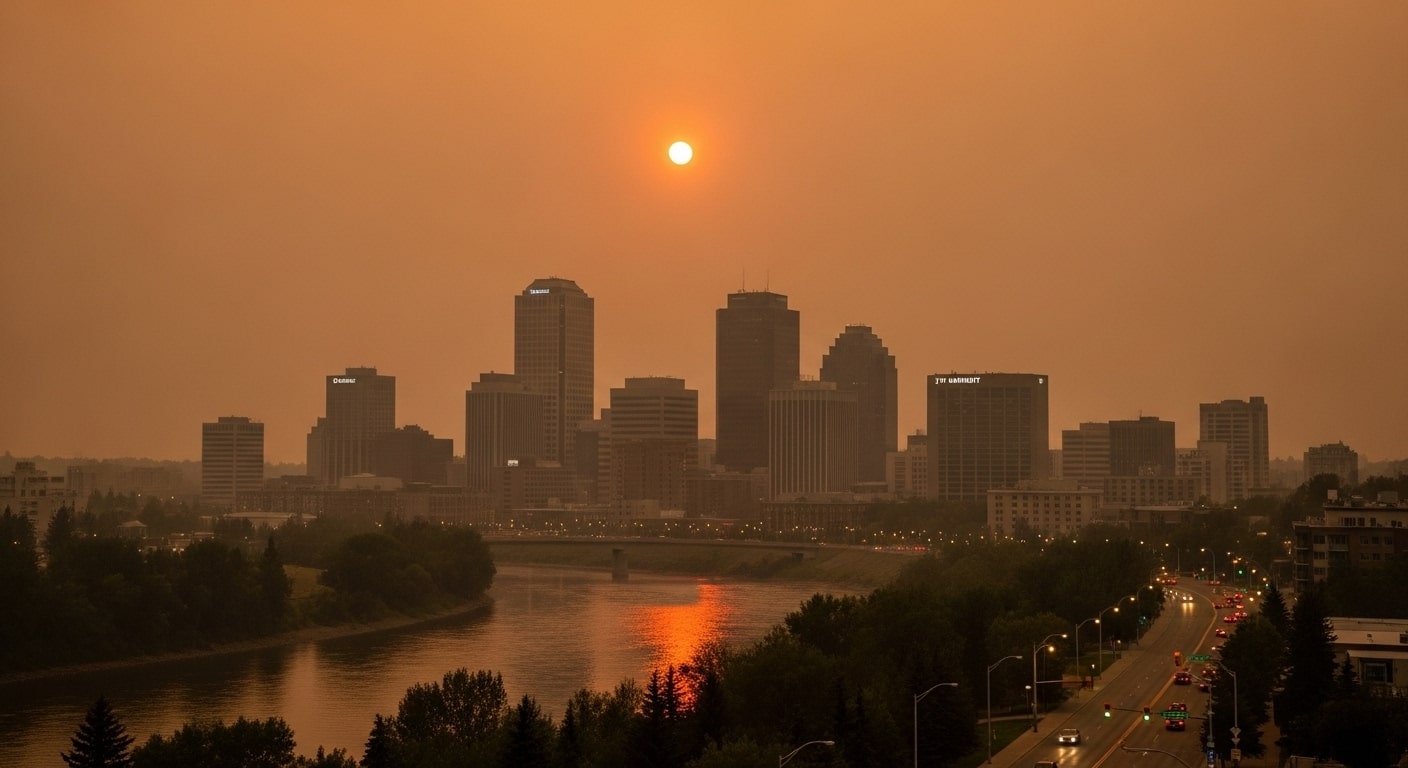
The Hazy Horizon: Where Edmonton’s Smoke Is Coming From
Over the past several days, residents of Edmonton have woken up to a familiar, yet unwelcome sight: a thick haze of smoke blanketing the city. The smell of burning wood is unmistakable, and a ghostly, orange-tinted sun hangs in the sky, casting a surreal glow over the urban landscape. This annual phenomenon, while a common reality for many Canadians, raises a pressing question for those on the ground: where is all this smoke actually originating? The answer, as confirmed by meteorological data and official reports, is not local. This pervasive smoke is a distant traveler, journeying hundreds of kilometers from active wildfires burning in remote areas, primarily in northern Alberta, and carried to the city by prevailing winds. Understanding the source is the first critical step toward comprehending the scale of the problem and taking necessary precautions to protect your health.
The primary source of the smoke currently affecting Edmonton is a cluster of significant wildfires burning across northern Alberta and parts of the Peace Region. While these fires are located far from the city itself, their immense size and intensity generate a massive volume of smoke. Atmospheric science explains how this smoke travels. High-altitude winds, specifically the westerly and northwesterly currents common in this part of the country, act like a massive conveyor belt, transporting the particulate matter from the fire zones directly toward more populated areas to the south. This means that even if there are no fires burning near your home, you can still experience severe air quality issues. The distance the smoke travels also means it can become more diffuse and settle at lower altitudes, creating the persistent haze that we see and feel.
For a more specific look at the culprits, experts point to several ongoing fires. Major burns in the Peace River region and others near communities such as Grande Prairie and High Level are generating the bulk of the smoke. These fires, often in remote, forested areas, can be incredibly difficult to contain, with crews working tirelessly on the ground and in the air. The sheer scale of these blazes means they can burn for weeks, or even months, depending on weather conditions, which include a lack of rainfall and higher-than-average temperatures. The long-duration nature of these fires ensures that as long as they are active and the wind is blowing in the right direction, the smoke will continue to be a regular feature in Edmonton’s air quality forecast.
Understanding the source is crucial, but what matters most for daily life in Edmonton is the Air Quality Health Index (AQHI). Today, the AQHI for Edmonton and surrounding areas is often rated as “high risk,” sometimes even reaching the “very high risk” category. The AQHI is a scale designed by the government to help people understand the health risks posed by air pollution on a scale of 1 to 10+. A high-risk rating indicates that air pollution has reached a level where both at-risk populations and the general public should take precautions. For example, at a high-risk level (7-10), children, the elderly, and those with respiratory issues are advised to avoid all strenuous outdoor activities, while the general population should consider reducing or rescheduling them.
The primary component of wildfire smoke that affects health is fine particulate matter, or PM2.5. These microscopic particles, less than 2.5 micrometers in diameter, are small enough to bypass the body’s natural defenses and penetrate deep into the lungs and even the bloodstream. Once inside, they can cause a range of health problems, including respiratory irritation, asthma attacks, and even cardiovascular issues. During periods of heavy smoke, the concentration of PM2.5 can skyrocket, making it hazardous for anyone to spend prolonged periods outdoors without proper protection. Health authorities issue these AQHI warnings specifically to alert the public to these invisible dangers, advising them to take the necessary steps to minimize exposure to these harmful pollutants.
The impact of this smoke is not uniform; different populations experience the effects in varying degrees. The most vulnerable groups include seniors, infants, and individuals with pre-existing health conditions such as asthma, chronic obstructive pulmonary disease (COPD), and heart disease. For these at-risk individuals, even a moderate amount of smoke can trigger severe symptoms, from coughing and shortness of breath to chest pain. Pregnant women and outdoor workers are also considered at risk and should take extra precautions. Health officials provide clear guidance: when the air quality is poor, at-risk individuals should stay indoors in a well-ventilated space and avoid all strenuous outdoor activities. The general public should also pay attention to these warnings and listen to their own bodies.
When the air is thick with smoke, your home becomes your sanctuary, and managing indoor air quality is paramount. The first and most effective step is to keep all windows and doors closed. This simple action can dramatically reduce the amount of PM2.5 entering your home. If you have an air conditioning system, make sure it is set to recirculate indoor air rather than pulling from outside. For those with forced-air heating systems, ensuring the furnace filter is clean and of a high quality (MERV 13 or higher) can help trap particulates. Additionally, using a portable air purifier can be highly effective at cleaning the air in the rooms where you spend the most time, such as bedrooms and living areas.
For those who must venture outside, wearing an N95 respirator mask can offer a significant degree of protection. These masks are specifically designed to filter out 95% of airborne particles, including PM2.5. It is important to note that surgical masks or cloth masks offer little to no protection against these microscopic particles. When using an N95 mask, it is crucial to ensure a proper fit to create a seal around your nose and mouth. People who work outdoors, such as construction workers or landscapers, should consult with their employers about safety protocols and consider adjusting their work schedules to avoid the worst periods of smoke. Staying hydrated is also important as it can help your body manage the effects of the air pollution.
This year’s smoke event, while impactful, can be viewed in the broader context of a changing climate. The frequency and intensity of wildfires across North America have been increasing, a trend many experts attribute to warmer temperatures and drier conditions. This means that what was once a rare, seasonal inconvenience has become a more regular occurrence, necessitating a long-term approach to public health and safety. The current situation in Edmonton is a microcosm of a larger, continental issue, with smoke plumes from Canadian wildfires often reaching as far as the central United States. As summers become longer and hotter, communities are being forced to adapt to what is becoming the new normal for air quality during fire season.
The long-term health implications of prolonged exposure to wildfire smoke are a significant concern. Research has shown that sustained inhalation of PM2.5 can lead to chronic respiratory illnesses, cardiovascular disease, and other serious health problems over time. For this reason, authorities like Alberta Health Services and Environment and Climate Change Canada are continuously monitoring conditions and issuing updated forecasts. These agencies are not only providing real-time data but also working to educate the public on the science behind air pollution and its effects. The cumulative impact of consecutive years of smoky summers underscores the need for proactive public health strategies and personal awareness, urging residents to take these warnings seriously even if the smoke has become a regular occurrence.
Staying Safe in the Smoke: A Practical Checklist
- Monitor the AQHI: Regularly check the Air Quality Health Index (AQHI) for your specific area. This is the single most important action you can take to make informed decisions about your daily activities. The index is updated hourly and is available on multiple government websites and weather apps.
- Stay Indoors and Limit Activity: When the AQHI is high, the best way to protect your health is to remain indoors with windows and doors closed. Avoid strenuous outdoor exercise like running or cycling, as this increases your inhalation of harmful particles. This is especially important for at-risk groups.
- Create a Clean Air Zone: Designate a room in your home as a clean air zone. This room can be sealed off and equipped with a high-efficiency particulate air (HEPA) filter to keep the air as clean as possible. This is particularly useful for people who have chronic respiratory conditions.
- Use an N95 Mask When Outdoors: If you must go outside, wear a properly fitted N95 respirator mask. Standard surgical or cloth masks are not effective against the fine particulate matter found in wildfire smoke. Ensure the mask fits snugly to filter the air you breathe.
- Avoid Adding to the Pollution: Do not add to the air pollution by burning candles, using a wood-burning fireplace, or smoking indoors. These activities can release additional particulates and worsen the air quality inside your home, compounding the problem.
- Stay Hydrated: Drinking plenty of water is a simple but important way to help your body. Staying hydrated can help reduce throat and nose irritation caused by the smoke and support your overall well-being.
The current smoke event affecting Edmonton is a direct consequence of large-scale wildfires in northern Alberta, transported by prevailing winds. This phenomenon, while increasingly common, poses significant health risks due to the presence of fine particulate matter. As a community, it is essential to stay informed about the Air Quality Health Index (AQHI) and to take proactive steps to protect personal health. From staying indoors to using air purifiers and wearing appropriate masks, these measures can make a substantial difference in mitigating the harmful effects of air pollution. The situation also serves as a poignant reminder of the broader environmental challenges facing the region and the critical importance of
AQHI RatingHealth RiskGeneral Population AdviceAt-Risk Population Advice1-3Low RiskEnjoy your outdoor activities. No special precautions are needed.Enjoy your normal outdoor activities.
4-6Moderate RiskNo need to modify usual outdoor activities.Consider reducing or rescheduling strenuous activities outdoors if you experience symptoms.
7-10High RiskReduce or reschedule strenuous activities outdoors if you experience symptoms.Avoid all strenuous outdoor activities.
10+Very High RiskAvoid strenuous activities outdoors.Avoid all outdoor activities.
The ongoing smoke event is a compelling and visible reminder of how interconnected our environment is. A wildfire burning hundreds of kilometers away can directly impact the daily lives of millions of people in a major urban center. This reality underscores the need for a comprehensive and collaborative approach to wildfire management and climate change mitigation. While individuals can and should take steps to protect themselves and their families, the long-term solution lies in addressing the root causes of these fires. Until then, vigilance, awareness, and proactive measures remain the best tools for navigating the hazy days of fire season.
The current air quality issues in Edmonton, driven by distant wildfires, represent more than just a passing inconvenience. They are a tangible example of the evolving relationship between our urban environments and the natural world around us. By understanding the source of the smoke and the health risks it poses, residents can make informed decisions that protect their well-being. As these events become a more frequent part of our summer and autumn, a culture of preparedness and public health awareness will be essential for ensuring the safety and resilience of communities like Edmonton.








